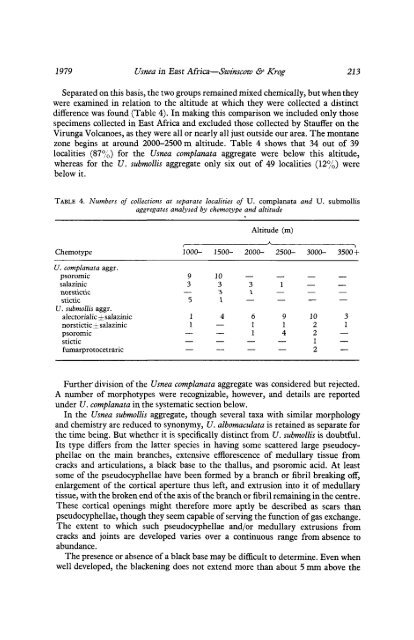The Fruticose Species of Usnea Subgenus Usnea in East Africa
The Fruticose Species of Usnea Subgenus Usnea in East Africa
The Fruticose Species of Usnea Subgenus Usnea in East Africa
Create successful ePaper yourself
Turn your PDF publications into a flip-book with our unique Google optimized e-Paper software.
1979 <strong>Usnea</strong> <strong>in</strong> <strong>East</strong> <strong>Africa</strong>—Sw<strong>in</strong>scow & Krog 213<br />
Separated on this basis, the two groups rema<strong>in</strong>ed mixed chemically, but when they<br />
were exam<strong>in</strong>ed <strong>in</strong> relation to the altitude at which they were collected a dist<strong>in</strong>ct<br />
difference was found (Table 4). In mak<strong>in</strong>g this comparison we <strong>in</strong>cluded only those<br />
specimens collected <strong>in</strong> <strong>East</strong> <strong>Africa</strong> and excluded those collected by Stauffer on the<br />
Virunga Volcanoes, as they were all or nearly all just outside our area. <strong>The</strong> montane<br />
zone beg<strong>in</strong>s at around 2000-2500 m altitude. Table 4 shows that 34 out <strong>of</strong> 39<br />
localities (87%) for the <strong>Usnea</strong> complanata aggregate were below this altitude,<br />
whereas for the U. suhmollis aggregate only six out <strong>of</strong> 49 localities (12%) were<br />
below it.<br />
TABLE 4. Numbers <strong>of</strong> collections at separate localities <strong>of</strong> U. complanata and U. submollis<br />
aggregates analysed by chemotype and altitude<br />
Chemotype<br />
U. complanata aggr.<br />
psoromic<br />
salaz<strong>in</strong>ic<br />
norstictic<br />
stictic<br />
U. submollis aggr.<br />
alectorialic +_ salaz<strong>in</strong>ic<br />
norstictic ± salaz<strong>in</strong>ic<br />
psoromic<br />
stictic<br />
fumarprotocetraric<br />
— — — —<br />
— — — —<br />
1<br />
2<br />
Altitude (m)<br />
A<br />
1000-<br />
9<br />
3<br />
—<br />
5<br />
1<br />
1<br />
—<br />
1500-<br />
10<br />
3<br />
3<br />
1<br />
4<br />
—<br />
—<br />
2000-<br />
—<br />
3<br />
\<br />
—<br />
6<br />
1<br />
1<br />
2500-<br />
—<br />
1<br />
—<br />
—<br />
9<br />
1<br />
4<br />
3000-<br />
—<br />
—<br />
—<br />
—<br />
10<br />
2<br />
2<br />
3500 +<br />
—<br />
—<br />
——<br />
3<br />
1<br />
—<br />
—<br />
—<br />
Further 1 division <strong>of</strong> the <strong>Usnea</strong> complanata aggregate was considered but rejected.<br />
A number <strong>of</strong> morphotypes were recognizable, however, and details are reported<br />
under U. complanata <strong>in</strong> the systematic section below.<br />
In the <strong>Usnea</strong> suhmollis aggregate, though several taxa with similar morphology<br />
and chemistry are reduced to synonymy, U. albomaculata is reta<strong>in</strong>ed as separate for<br />
the time be<strong>in</strong>g. But whether it is specifically dist<strong>in</strong>ct from U. submollis is doubtful.<br />
Its type differs from the latter species <strong>in</strong> hav<strong>in</strong>g some scattered large pseudocyphellae<br />
on the ma<strong>in</strong> branches, extensive efflorescence <strong>of</strong> medullary tissue from<br />
cracks and articulations, a black base to the thallus, and psoromic acid. At least<br />
some <strong>of</strong> the pseudocyphellae have been formed by a branch or fibril break<strong>in</strong>g <strong>of</strong>f,<br />
enlargement <strong>of</strong> the cortical aperture thus left, and extrusion <strong>in</strong>to it <strong>of</strong> medullary<br />
tissue, with the broken end <strong>of</strong> the axis <strong>of</strong> the branch or fibril rema<strong>in</strong><strong>in</strong>g <strong>in</strong> the centre.<br />
<strong>The</strong>se cortical open<strong>in</strong>gs might therefore more aptly be described as scars than<br />
pseudocyphellae, though they seem capable <strong>of</strong> serv<strong>in</strong>g the function <strong>of</strong> gas exchange.<br />
<strong>The</strong> extent to which such pseudocyphellae and/or medullary extrusions from<br />
cracks and jo<strong>in</strong>ts are developed varies over a cont<strong>in</strong>uous range from absence to<br />
abundance.<br />
<strong>The</strong> presence or absence <strong>of</strong> a black base may be difficult to determ<strong>in</strong>e. Even when<br />
well developed, the blacken<strong>in</strong>g does not extend more than about 5 mm above the
















